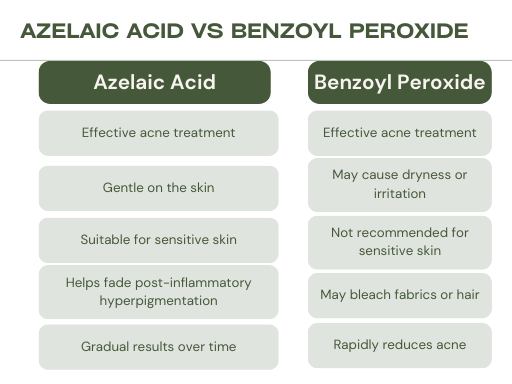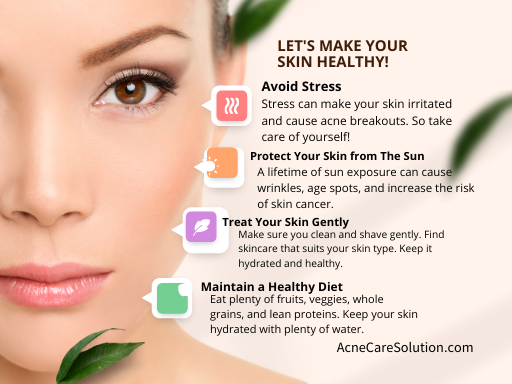Azelaic Acid vs Benzoyl peroxide? Have you ever felt like you were in a tug-of-war between two skincare products, unsure which one to choose? Both have their benefits, but which one reigns supreme? Azelaic acid and benzoyl peroxide target acne-prone skin but work differently.
Azelaic acid helps reduce inflammation caused by bacteria while brightening skin tone, making it ideal for those with sensitive skin or hyperpigmentation concerns.
On the other hand, Benzoyl peroxide kills acne-causing bacteria by introducing oxygen into the pores.
So which should you choose to treat acne: azelaic acid or benzoyl peroxide? Let’s dive into the details to help you make an informed decision leading to clearer, hea
Table of Contents
ToggleWhat Is Azelaic Acid?
Azelaic acid is a skincare ingredient that has gained popularity recently due to its efficacy as an acne treatment. Compared to benzoyl peroxide, another popular acne-fighting ingredient, azelaic acid is less harsh on the skin while still delivering impressive results.
It kills bacteria on the skin’s surface while reducing inflammation and lightening dark spots left behind by acne.
Overall, azelaic acid is an excellent option for those looking for an effective yet gentle way to treat their acne.
Benefits Of Azelaic Acid
- Inflammatory Acne: Azelaic acid exhibits anti-inflammatory properties, which make it effective in reducing the redness, swelling, and inflammation associated with inflammatory acne. It helps calm down active breakouts and can particularly benefit papules and pustules.
- Comedonal Acne: Azelaic acid also addresses comedonal acne, characterized by clogged pores, blackheads, and whiteheads. It helps to unclog pores, exfoliate the skin, and reduce the formation of new comedones, thus promoting a clearer complexion.
- Post-Inflammatory Hyperpigmentation (PIH): Azelaic acid is known to have skin-brightening properties and can help fade post-inflammatory hyperpigmentation (dark spots) left behind after acne breakouts. It works by inhibiting melanin production, the pigment that darkens the skin.
- Maintenance and Preventive Treatment: Even after clearing acne, azelaic acid can be used as a maintenance treatment to prevent new breakouts and maintain the overall health of the skin. It can help regulate sebum production, keep the pores clear, and minimize the chances of acne recurrence.

Application and Usage of azelaic acid
Choosing the Right Formulation:
- Azelaic acid is available in various formulations, including creams, gels, serums, and lotions.
Cleansing and Preparation:
- Start by cleansing your face with a gentle cleanser to remove dirt, oil, and makeup.
- Pat your skin dry and allow it to air dry completely before applying azelaic acid.
Applying Azelaic Acid:
- Typically, a pea-sized amount is sufficient to cover the entire face.
- Apply a thin layer of azelaic acid to the affected areas or the entire face, depending on the recommended Usage.
Frequency of Use:
- Azelaic acid can be used once or twice daily, depending on the product and your skin’s tolerance.
- Start with less frequent applications (e.g., once daily) and gradually increase as your skin adjusts.
Combining Azelaic Acid with Other Products:
- Azelaic acid can be used in combination with other skincare products.
- Depending on the specific product instructions, it can be applied before or after moisturizers, sunscreen, or other treatments.
Sun Protection:
- Azelaic acid may increase the skin’s sensitivity to the sun.
- Always apply a broad-spectrum sunscreen with at least SPF 30 when using azelaic acid during the day.
Patience and Consistency:
- Results from azelaic acid may take time to become noticeable.
- Be patient and consistent with your application to achieve optimal results.
- It may take several weeks or even months to see significant improvements in your skin.
Monitoring and Adjustments:
- Observe how your skin responds to azelaic acid.
- If you experience excessive dryness, irritation, or other concerning reactions, reduce the frequency or discontinue use and consult a healthcare professional.
Azelaic acid products
Several azelaic acid products are available on the market for various skin care concerns. Here are some examples:
Azelaic Acid Creams:
- Prescription Strength: Azelaic acid creams with higher concentrations (e.g., 15% or 20%) are available by prescription for treating acne, rosacea, and hyperpigmentation.
- Over-the-Counter (OTC) Strength: Some over-the-counter azelaic acid creams contain lower concentrations (e.g., 10%) and are primarily marketed for acne treatment and brightening the skin.
Azelaic Acid Gels:
- Azelaic acid gels are commonly prescribed for acne treatment and may contain 10% to 20%. These gels are designed to be lightweight and easily absorbed into the skin.
Azelaic Acid Serums:
- Azelaic acid serums are lightweight formulations targeting specific areas of concern, such as hyperpigmentation or acne spots. They are often used as part of a broader skincare routine.
Combination Products:
- Some products combine azelaic acid with other active ingredients, such as retinoids or hydroquinone, to provide multiple benefits in a single formulation. These combination products may be prescribed for specific skin conditions like melasma or hyperpigmentation disorders.
Skincare Products:
- Azelaic acid is also found in some skincare products, including cleansers, toners, and masks. These products may contain lower concentrations of azelaic acid and are typically used for overall skin health.

Side Effects Of Azelaic Acid
It’s now time to look at azelaic acid and its side effects. While benzoyl peroxide is known for its antibacterial properties, azelaic acid works differently by reducing inflammation and preventing clogged pores.
One possible side effect of using azelaic acid is dryness or peeling of the skin. This occurs more frequently if the treatment is used too often or in high concentrations. Some individuals may also experience itching, burning, or stinging sensations upon application.
Most people can tolerate this treatment without significant discomfort with proper use and monitoring. Both benzoyl peroxide and azelaic acid are effective options for treating acne, but understanding their differences and potential side effects can help you decide which one is best suited for your individual needs.
What Is Benzoyl Peroxide?
Benzoyl peroxide is a common active ingredient found in many acne products. It works by reducing the amount of bacteria on the skin and decreasing inflammation, and unclogging pores.
This powerful topical medication can be purchased over the counter or prescribed by a board-certified dermatologist. While benzoyl peroxide can be effective in treating mild acne to moderate acne, it’s important to note that it may not work for everyone, and there are possible side effects such as dryness, redness, and peeling of the skin.
In addition, using too much benzoyl peroxide can worsen acne instead of improving it. Therefore, it’s recommended to start with a lower concentration (2.5%) and gradually increase if necessary.
Benzoyl peroxide is a commonly used ingredient in acne treatment products. It is available in various forms, including creams, gels, cleansers, and spot treatments. These products contain different concentrations of benzoyl peroxide, usually ranging from 2.5% to 10%.
Benefits Of Benzoyl Peroxide
Antibacterial agents such as benzoyl peroxide and tea tree oil can effectively target and eliminate acne-causing bacteria on the skin.
- Kills Acne-Causing Bacteria: Benzoyl peroxide is a powerful antibacterial agent that effectively kills the bacteria (Propionibacterium acnes) responsible for causing acne breakouts. Eliminating these bacteria helps reduce inflammation and prevent new acne lesions from forming.
- Unclogs Pores: Benzoyl peroxide penetrates the pores and helps to loosen and remove built-up dead skin cells, excess oil, and debris. Unclogging the pores reduces the formation of blackheads, whiteheads, and other types of acne.
- Reduces Excess Oil Production: Benzoyl peroxide can help regulate skin sebum (oil) production. Reducing excessive oiliness helps to prevent pore blockage and breakouts.
- Anti-Inflammatory Properties: Benzoyl peroxide has anti-inflammatory properties, which can help to calm redness, swelling, and irritation associated with acne. It can also help to minimize the appearance of inflamed pimples.
- Effectiveness on Different Types of Acne: Benzoyl peroxide treats various types of acne, including mild to moderate inflammatory acne, papules, pustules, and sometimes even cystic acne. It can be used as a stand-alone treatment or with other acne-fighting ingredients.
- Over-the-Counter Availability: Benzoyl peroxide is readily available in various forms, including creams, gels, lotions, and cleansers. This accessibility makes it a widely used and easily accessible acne treatment option
.
Side Effects Of Benzoyl Peroxide
Here are some potential side effects of benzoyl peroxide:
- Dryness and Peeling: Benzoyl peroxide can cause dryness and peeling of the skin. It may strip away some of the skin’s natural oils, leading to dry and flaky skin. This can be more prominent in individuals with dry or sensitive skin.
- Redness and Irritation: Some people may experience redness, itching, and skin irritation when using benzoyl peroxide. This is more common in individuals with sensitive skin or when using higher ingredient concentrations.
- Sensitivity to Sunlight: Benzoyl peroxide can make the skin more sensitive to sunlight. Using sunscreen with a sufficient sun protection factor (SPF) is essential to protect the skin from harmful UV rays and reduce the risk of sunburn and sun damage.
Which Is Better For Treating Acne? Azelaic Acid vs Benzoyl Peroxide
Did you know that acne affects up to 50 million people in the United States alone? It’s a common skin condition that can be physically and emotionally distressing.
If you have sensitive or dry skin:
- Azelaic acid may be a better option as it tends to be gentler on the skin and has fewer reported side effects, such as dryness and irritation.
If you have oily or acne-prone skin:
- Benzoyl peroxide may be more suitable as it has strong antibacterial properties that effectively target acne-causing bacteria and reduce inflammation.
Can I Use Benzoyl Peroxide And Azelaic Acid Together?
The good news is, yes, you can! Combining these two topical acne treatments can lead to even more effective results.
When used in conjunction, they create a powerful duo that can combat stubborn breakouts and prevents new ones from forming.
However, it’s important to note that spot treatments containing either ingredient should not be layered or applied simultaneously, as this could potentially irritate your skin.Instead, alternate between using one in the morning and the other at night for the best results.
Conclusion : Azelaic acid vs benzoyl peroxide
In conclusion, both azelaic acid and benzoyl peroxide effectively treat acne. Combining a consistent skincare routine, a healthy diet, and regular exercise can lead to an effective treatment plan for managing acne and achieving clearer skin.
Azelaic acid has fewer side effects than benzoyl peroxide, making it a better option for sensitive skin types. On the other hand, benzoyl peroxide is known to be more effective in treating severe acne.
A combination of salicylic acid, benzoyl peroxide, and azelaic acid is an effective acne treatment regimen for many individuals.
Remember, taking care of our skin is crucial for overall health and confidence – don’t hesitate to seek help if needed! After all, clear skin equals happiness (okay, that’s a bit hyperbolic, but you get the point!).
